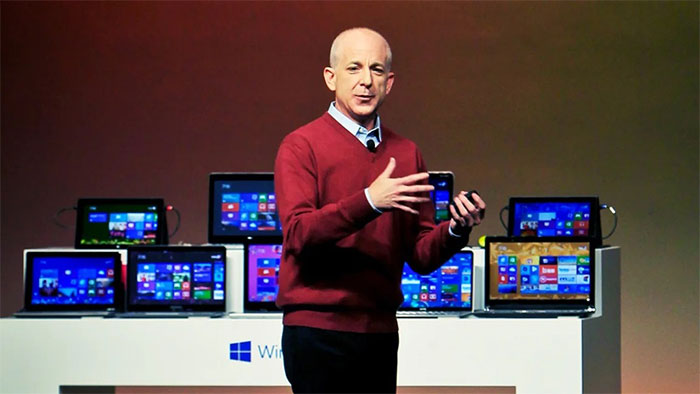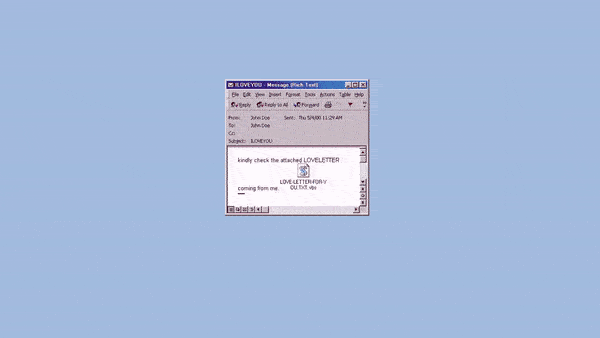Three types of computer viruses once haunted the world
Steven Sinofsky, former head of Microsoft's Windows and Office division, recalled his experience with the ILOVEYOU virus that spread to the world in 2000.
One morning in 2000, Steven Sinofky, then Microsoft business software manager, received a strange call from a female journalist before driving to work with the mysterious message 'I love you. , I love you '(I love you, I love you).

Steven Sinofsky has been the leader of Office and Windows at Microsoft for many years. (Photo: Getty).
Before Sinofky could understand the story, ILOVEYOU - the 'cute' computer virus, had infiltrated the entire Internet system, destroying millions of email inboxes worldwide through Microsoft Outlook and Exchange software. .
The first lesson of Microsoft
In his Fast Company article, Sinofsky said that ILOVEYOU was not the first virus to cause headaches for Microsoft executives. In the mid-1990s, Microsoft had to deal with completely new viruses.
A virus called WM / Concept.A does not take advantage of errors or programming errors in Word. The exploited vulnerability is macros of Word 6.0. Considered to be an achievement in boosting productivity, a macro command allows users to record their actions and repeat them.

Viruses are an obsession with solution providers like Microsoft. (Photo: Fast Company).
WM / Concept.A takes advantage of the ability to open and execute as soon as the file is clicked to infect the computer. After the executable file is opened, every document on the computer will be infected with the virus, and every time it is shared via the virus network, it is also distributed.
"Unlike what people often think, successful viruses do not do harmful tasks like wiping files or reinstalling the hard drive. If they do, they will not spread, and lose their purpose. original " , Mr. Sinofsky described.
By that standard, WM / Concept.A was so successful in the global distribution that what it did was just annoying users. When opening files with viruses, an error window will pop up, and users just need to press "OK" to be able to ignore. Removing the virus is quite simple, but it also creates a new industry: antivirus.

The WM / Concept.A virus does not cause much harm to computers, but spreads very quickly and opens up the anti-virus service industry. (Photo: Fast Company).
"WM / Concept.A is our first lesson on the balance between building a scalable, customizable system and ensuring the safety and reliability of computers; just as users can respond. "If there is a high level of security, the way the work will change , " Sinofsky described the first lesson of the virus.
Crashes Microsoft server
In 1999, Microsoft received the next lesson on viruses. Mr. Sinofky described one morning, he received a series of unusual emails on Outlook with the subject line 'Important Message from. . . ' (This is an important message for .)
Each message contains only one text 'This is the document you requested . don't show it to others ;-)' , along with the attached .doc file.
Sinofky is not the only one who receives this strange message chain, but at the same time, all Outlook users receive it.

W97M.Melissa virus infects hundreds of thousands of people when sending themselves via email. (Photo: Fast Company).
Soon after, the worldwide email service system stopped working.
The culprit is this W97M.Melissa virus . Also exploiting vulnerabilities from macros but copying itself via email, Mellisa has completely paralyzed the global email service.
After being spread via an intentionally simple email, the Melissa virus spread when the recipient opened the attached file. The message is designed to look familiar, so most users open the file.
If users launch from Outlook, the Melissa virus code will use macros to send the same 'Important message' to the first 50 people in the Outlook address book. Each infected person will infect 50 people, and each person opening the attachment spreads to an additional 50 people.
The incident happened over the weekend, meaning millions of users worldwide won't be able to use email when the workday on Monday begins.
"Our customers and offices around the world are angry," Sinofsky described.
This is the first virus called a "worm" , because of its ability to spread itself to other computers without the user's action. It also makes good use of the psychological aspect, a trick later called "social engineering".
Sinofsky said that Melissa has once again pointed out limitations on Microsoft's software design.
"Our products and customers are at risk as the world becomes more connected. Effective design approaches with technology-savvy people are now ineffective as more and more Internet users don't understand. how computers work, "said the former Microsoft executive.
The price of ILOVEYOU
ILOVEYOU also spreads via email, but instead of sending it to the first 50 people in the directory, it sends an email to the whole. It also installs a copy on your computer to run in the background all the time, delete files and replace them with virus copies.
The consequences of ILOVEYOU amount to billions of dollars. Some experts said that just one morning, half of North American computers were infected with ILOVEYOU virus, and about 100,000 email servers in Europe were infected or shut down as a precaution.
The ILOVEYOU virus has even disabled servers and networked computers in many important government agencies from the US Department of Defense to the UK National Health Service.

In just a few weeks, the ILOVEYOU virus has caused billions of dollars in damage. (Photo: Fast Company).
"It was bad, very bad. Our team had to find a way to handle and consider many options , " Mr. Sinofsky recounted the period when Microsoft responded to the crisis. The former leader described the moment as a Tylenol crisis, causing seven deaths in 1982.
Facing such risks, Microsoft must take strong measures such as disabling sending a variety of attachments or executing executable code, cutting contact list access or marking any email as not worthwhile. trust.
However, it will take up to 4 weeks for Microsoft to complete the patch and fix bugs that ILOVEYOU exploits.
With ILOVEYOU, Mr. Sinofsky once again affirmed the different views of computer users and general users. That's the big lesson of Microsoft: how to design safe software that common users accept to use.
"Everyone is busy and just wants the computer to work stable, " Mr. Sinofsky said.
- The most dangerous computer viruses of all time
- What is a virus? How is the virus spread?
- The most dangerous computer viruses of the time
- Asia: 26 types of viruses are spreading strongly!
- Face 25 most terrible computer viruses of all time
- Computer virus appearances can
- What is a virus? How is the virus infected?
- The most frightening rooms in the world
- 7 most terrifying haunted houses in the world for Halloween
- Internal troubles are more worrisome than computer viruses
- Taking advantage of children to infect the virus
- 10 most dangerous viruses of all time
- 'The creepy mystery' in the supposedly haunted villages
- People infected with computer viruses!
 What is the Snapdragon SiP chip?
What is the Snapdragon SiP chip? How to create a yellow circle around the mouse cursor on Windows
How to create a yellow circle around the mouse cursor on Windows Edit the Boot.ini file in Windows XP
Edit the Boot.ini file in Windows XP 3 ways to restart the remote computer via the Internet
3 ways to restart the remote computer via the Internet